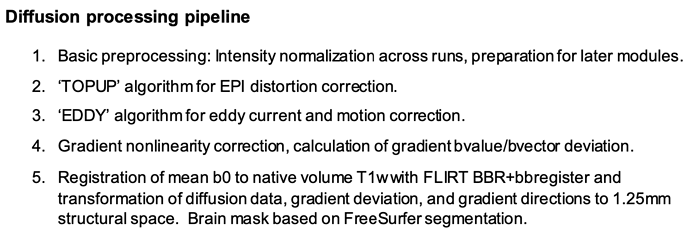Hi MRtrix3 Community,
I’m working on my pipeline to generate a whole-brain connectome. I think I have it almost down, however, I’m a beginner so there may be some problems and I would like to figure out a few details. I’d appreciate it if someone can take a look and provide advice.
I mainly follow the steps in this tutorial.
The problems I want to figure out are listed as follows:
- Is it suitable to downsample data using
mrtransformin the code? - I wonder if the order of downsampling and preprocessing matters a lot.
- Is there a voxel-wise method for connectome generation?
0 About data
I’m using HCP DWI preprocessed data. According to the doc, some preprocessing steps have already been done shown in the following figure:
1 Convert DWI to mif
mrconvert -fslgrad bvecs bvals data.nii.gz 'dwi.mif'
mrtransform T1w.nii.gz -template MNI152_T1_2mm.nii.gz T1w_MNI2mm.nii.gz
mrtransform dwi.mif -template MNI152_T1_2mm.nii.gz dwi_MNI2mm.mif
In the previous topic (Get stuck when import DWI data - #4 by jdtournier), Dr.Donald suggested I not to downsample the data, however, considering DWI data is just a part of my task, I need to adjust it to fit other data in MNI2mm space.
2 preprocess DWI
-
dwi2mask— create a mask for preprocessing dwidenoisedwidegibbs- Since
TOPUPandEDDYhave already been done in the HCP pipeline. I skip them in my pipeline. - When it comes to
dwibiascorrect, in the tutorial, it is said that this command is an optional step that can lead to a better mask estimation, so I choose not to use it.
3 Calculate CSD
-
dwi2mask— create a mask to restrict my analysis to voxels that are located within the brain dwi2responsedwi2fod
4 Generate a whole-brain tractography
tckgen -algo iFOD2 -act 5ttseg.mif -backtrack -crop_at_gmwmi -nthreads 24 \
-cutoff 0.05 -angle 45 -minlength 20 -maxlength 250 \
-seed_image dwi_wmMask.mif -select 10000k dwi_wmCsd.mif \
fibs_10M_act.tck
tckedit fibs_10M_act.tck -number 200k fibs_select200k.tck
tcksift2 -act 5ttseg.mif -out_mu sift_mu.txt -out_coeffs sift_coeffs.txt \
-nthreads 24 fibs_10M_act.tck dwi_wmCsd.mif sift_1M.txt
5 Generate connectome
tck2connectome
Thanks,
Volcano
